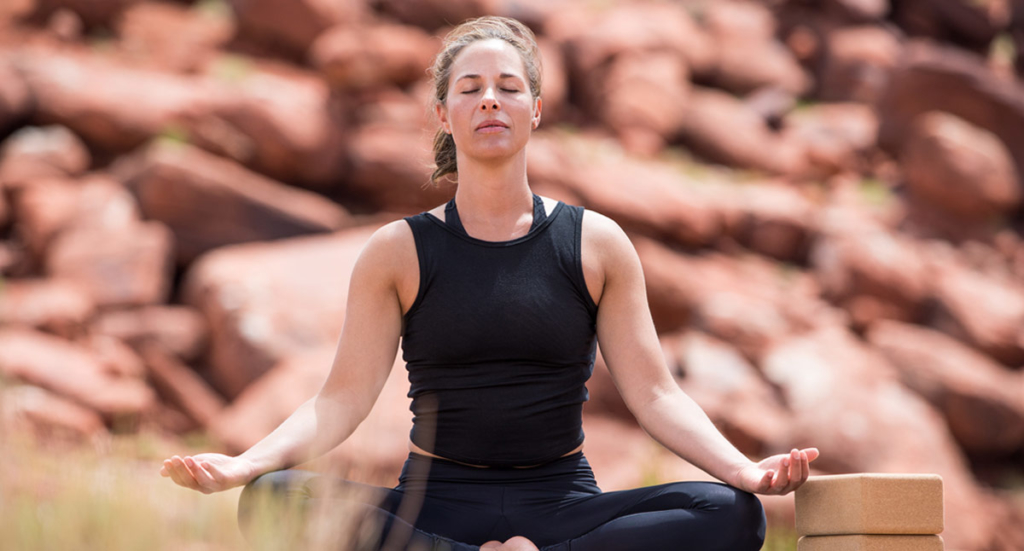
Our breath is like the flywheel that controls and regulates all our physiological processes. The rhythm of our breath regulates our heartbeat, among other things. This, in turn, affects our nervous system, which governs so many of our physical/mental/emotional processes. Traditionally, pranayama practice has been an equal partner to asana in the practice of hatha yoga. Even so, modern yoga practice generally gives only passing notice to pranayama. Yet, slowing your breathing through pranayama is key to achieving the true purpose of yoga: the setting of the mind into silence.
Pranayama is the fourth of the Eight Limbs of Yoga. It’s situated right after asana (physical postures) and just ahead of pratyahara (turning inward, away from the world of the senses). Pranayama sits right at the intersection of the external and internal limbs of yoga. It is the bridge between our physical, mental, emotional and spiritual worlds.
How Slowing Your Breathing Promotes Physical Health
A 2017 study explored the health benefits of slowing your breathing. It looked at several categories: respiratory, cardiovascular, cardiorespiratory and autonomic nervous system.
Among other benefits, the study found that slowing your breathing:
- Increases lung capacity and arterial oxygenation.
- Increases venous return and cardiac output; may decrease blood pressure.
- Augments baroreflex sensitivity.
- Increases vagal tone and shifts toward parasympathetic dominance.
When I studied yoga with B.K.S. Iyengar in India, out of all the things he told us, the one principle that I’ve always remembered is this. I’m paraphrasing here, but this is essentially what he said. “We practice yoga to create a peaceful, calm environment for our minds.”
All the benefits the above study found support the creation of a peaceful, calm environment for our minds. Slowing down your breathing then not only supports physical health. It also points you toward the deeper aim of yoga.
How to Practice Slowing Your Breathing
You can practice slowing your breathing from a supine or seated position. Here’s a post that outlines how to set up for supine pranayama practice. If you prefer seated practice, use a meditation cushion to help you sit in a spine-healthy position. This will enable deep breathing.
- Begin in a comfortable position—seated or supine—using whatever props enable you to breathe deeply.
- Breathe in, a little more deeply than normal, and count the length of your inhalation. This is not a competition! Inhale deeply, but not to the point of strain. Keep it slow, steady and comfortable.
- Now exhale for the same number of counts.
- Start with 5 to 10 breaths. Each week, you can increase the number of breaths by 3 to 5.
- When you finish, sit for a few minutes to feel the effects of your practice—on all levels.
Variations and Cautions
- Kumbhaka—inhalation-pause-exhalation: Many practitioners like to pause for an equal count at the top of each inhalation. If you choose to do this, be sure not to “catch” or close off the throat. Instead, simply stop the inhalation and pause there. This can be stimulating to the nervous system, so it can be energizing. If you feel a need for some fresh energy, try this practice, but be aware that it can raise your blood pressure. So if your blood pressure is already on the higher side, you should avoid kumbhaka practice.
- Parasympathetic practice: You can trigger your parasympathetic nervous system by slowing down your exhalation so that it’s a few counts longer than your inhalation. When you inhale, your heart beats faster than when you exhale. So slowing the exhalation down can, over time, slow the heartbeat as well. This process is called “sinus arhythmia.”
- Take breaks: If you find the practice to feel intense or if you feel short of breath, it’s likely that you are pushing the practice too hard. Stop the practice and take a few normal breaths to reset. Then resume, inhaling and exhaling slightly less deeply. Relax your body around your inhalations and exhalations.
There are lots of other variations to this practice, using hand mudras and more elaborate retentions. Pranayama is a powerful practice and in general, it’s best to work with an experienced teacher. However, simple practices such as slowing your breathing using counts, are generally safe to practice on your own. As always, if you feel strain, do less. Slowing your breathing is meant to calm the body/mind. So approach your practice with curiosity and care.
